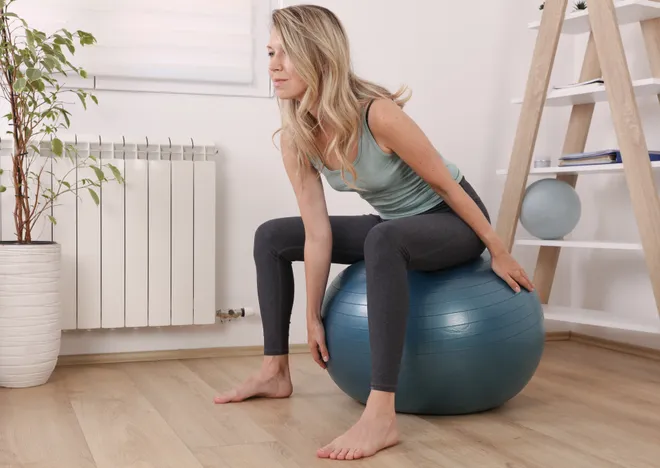Many women experience pain with sex. Is pelvic floor therapy the answer not enough people are talking about?
There are many different types of therapy – psychological, sexual, physical. But have you ever heard of pelvic floor therapy? Or, better yet, do you know what a pelvic floor is?
You probably don't know unless you've had some kind of issue with yours. The pelvic floor refers to the hammock of muscles and supporting connective tissue that supports your pelvic organs, i.e., anything below the belly button and between the the thighs. For women, this includes the urethra, bladder, vagina, uterus and surrounding intestines. Pelvic floor issues often come up postpartum – and can result in painful sexual experiences.
"(The pelvic floor muscles) are very overlooked in most people, because you can't really see them," says Dr. Cheryl Igelsia, urogynecology specialist at MedStar Health. "But they serve such an important function so that you're not pooping, peeing on yourself, and we can also engage in sexual relations and have orgasms."
When women have issues with their pelvic floors, it could mean leaking urine (urinary incontinence), pelvic organ prolapse (organs pressing down or into the vagina) or fecal incontinence. They may also have pain with sex, an issue that is rarely discussed but that research suggests impacts 10-28% of women during their lifetime.
Women – and at times men – who encounter issues with their pelvic floors can get help from pelvic floor physical therapists. These therapists will often give patients exercises to improve their aliments.
"The pelvic floor physical therapists are really specialized in helping women make sure that they're performing these exercises appropriately," says Dr. Victoria Scott, urologist and medical advisor at Flo.

Pelvic floor therapy, explained
Pelvic floor therapy helps men and women either tighten or loosen their pelvic floor muscles, depending on the issues at hand. Women may be instructed to practice Kegel exercises (squeezing and relaxing of the pelvic floor muscles), for example, to help tighten muscles. Signs women may need tightening if they can't make it to the bathroom on time or if pee comes out each time they laugh, cough or sneeze.
As for loosening: "A lot of women actually have pelvic floors that are too tight," Scott says. "So the pelvic floor physical therapist can be super helpful in identifying that, 'hey, stop doing the Kegels. We need to do stretching and relaxing techniques.'"
Both types of pelvic floor issues can cause pain during sex.
What to know before going to pelvic floor therapy
Often to resolve pelvic floor issues, a pelvic floor physical therapist will work with the patient on both internal and external exercises. Look at legitimate databases when seeking care and be wary of any providers that make you feel uncomfortable. (Look no further than the Larry Nassar case to see mismanaged pelvic floor treatment).
Also be sure to check which therapists are covered by insurance.
While you may need to work on these exercises the rest of your life – after all, you want your sex life to be as robust as possible, in addition to maintaining your overall health – don't expect to visit a physical therapist forever. "Maybe patients can expect weekly for about six weeks, and then at that time, typically as with any other PT like for your ankle or your knee, they might say, 'OK, I think you've got it. Call me if you need me in the future,'" Scott says.
Men may need pelvic floor therapy, too
We all have pelvic floors. Though pregnancy can make the therapy more applicable to women, men may also need help training their pelvic floors, particularly when it comes to bladder issues.
"It can be helpful for some men who have tighter pelvic floor muscles that cause more of a pelvic floor muscle dysfunction," Scott says. "So they're not relaxing their muscles properly, and this can cause pelvic pain, urinary urgency, frequency, difficulty emptying the bladder."
These men tried a period pain simulator.Their wild reactions carry an important message.
Can I try pelvic floor therapy at home?
Yes. You'll want to see a doctor first for a quick evaluation and to make sure nothing's wrong. Definitely go if you have blood in your urine or terrible pain.
But if you had a baby six months ago and still find yourself leaking urine, you can certainly try Kegel exercises on your own. Other exercises like squats and bridges can help engage pelvic floor muscles and core, and can also help treat and even prevent mild leakage in the future. Consider yoga, pilates and diaphragmatic breathing, too.
A pelvic floor physical therapist will help you make sure you're engaging muscles properly.
Whichever method you choose, retraining your pelvic floor could mean fewer medications, procedures or surgeries in the future, in addition to having more comfortable sex. Meaning, as Scott says, "this is a really good tool for the rest of your life."
In case you missed:Women are returning their period blood to the Earth. Why?
Disclaimer: The copyright of this article belongs to the original author. Reposting this article is solely for the purpose of information dissemination and does not constitute any investment advice. If there is any infringement, please contact us immediately. We will make corrections or deletions as necessary. Thank you.





